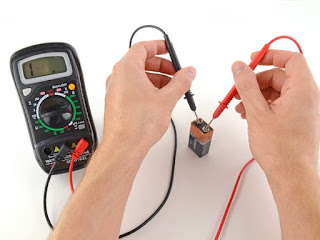Tuesday, 24 October 2017
using multimeter to test voltage
Testing Voltage
Plug the black probe into the COM port on your multimeter.
Plug the red probe into the VΩmA port.
Switch on your multimeter, and set the dial to DC voltage mode (indicated by a V with a straight line, or the symbol ⎓).
Virtually all consumer electronic devices run on DC voltage. AC voltage—the kind that runs through the lines to your house—is considerably more dangerous, and beyond the scope of this guide.
Most multimeters are not autoranging, meaning you will need to set the correct range for the voltage you expect to measure.
Each setting on the dial lists the maximum voltage it can measure. So for example, if you expect to measure more than 2 volts but less than 20, use the 20 volt setting.
If you're not sure, start with the highest setting.
Place the red probe on the positive terminal, and the black probe on the negative terminal.
If your range was set too high, you may not get a very accurate reading. Here the multimeter reads 9 volts. That's fine, but we can turn the dial to a lower range to get a better reading.
If you set the range too low, the multimeter simply reads 1 or OL, indicating that it is overloaded or out of range. This won't hurt the multimeter, but we need to set the dial to a higher range.
With the range set correctly, we get a reading of 9.42 volts.
Reversing the probes won't do any harm; it just gives us a negative reading.
Subscribe to:
Post Comments (Atom)
Perform housekeeping duties
the requirements of housekeeping The word “housekeeping” can interpret cleaning floors and surfaces, removing dust, and organizing clutter...

-
OH&S regulation for the it industry The purpose of the OHSR is to promote occupational health and safety and to protect workers...
-
To begin, make sure no current is running through the circuit or component you want to test. Switch it off, unplug it from the wall, and rem...










No comments:
Post a Comment